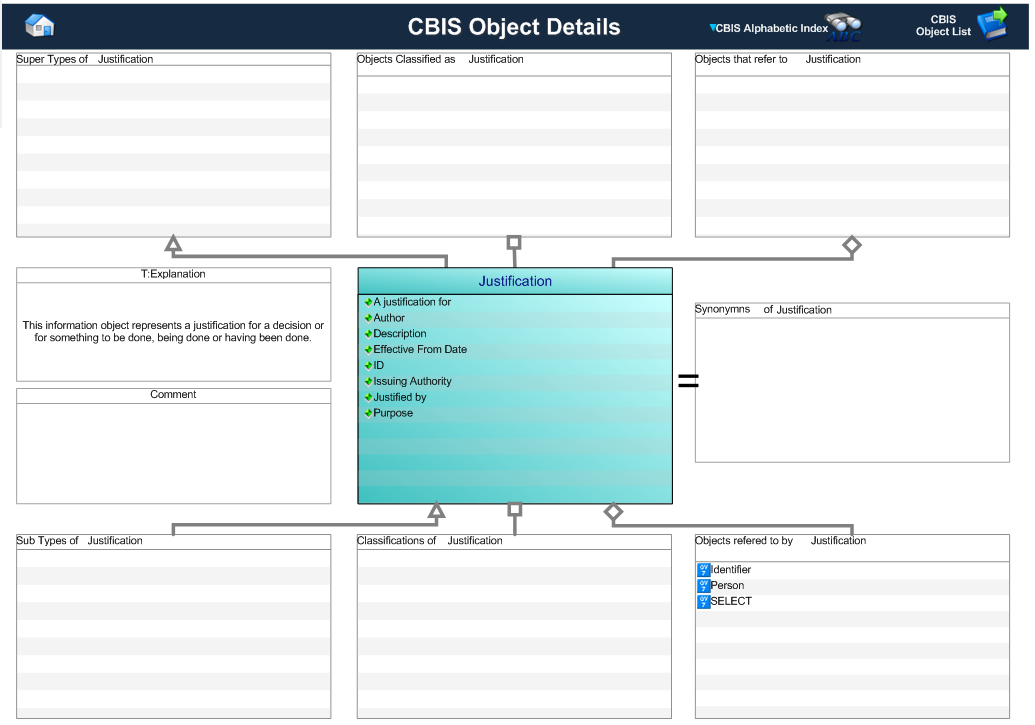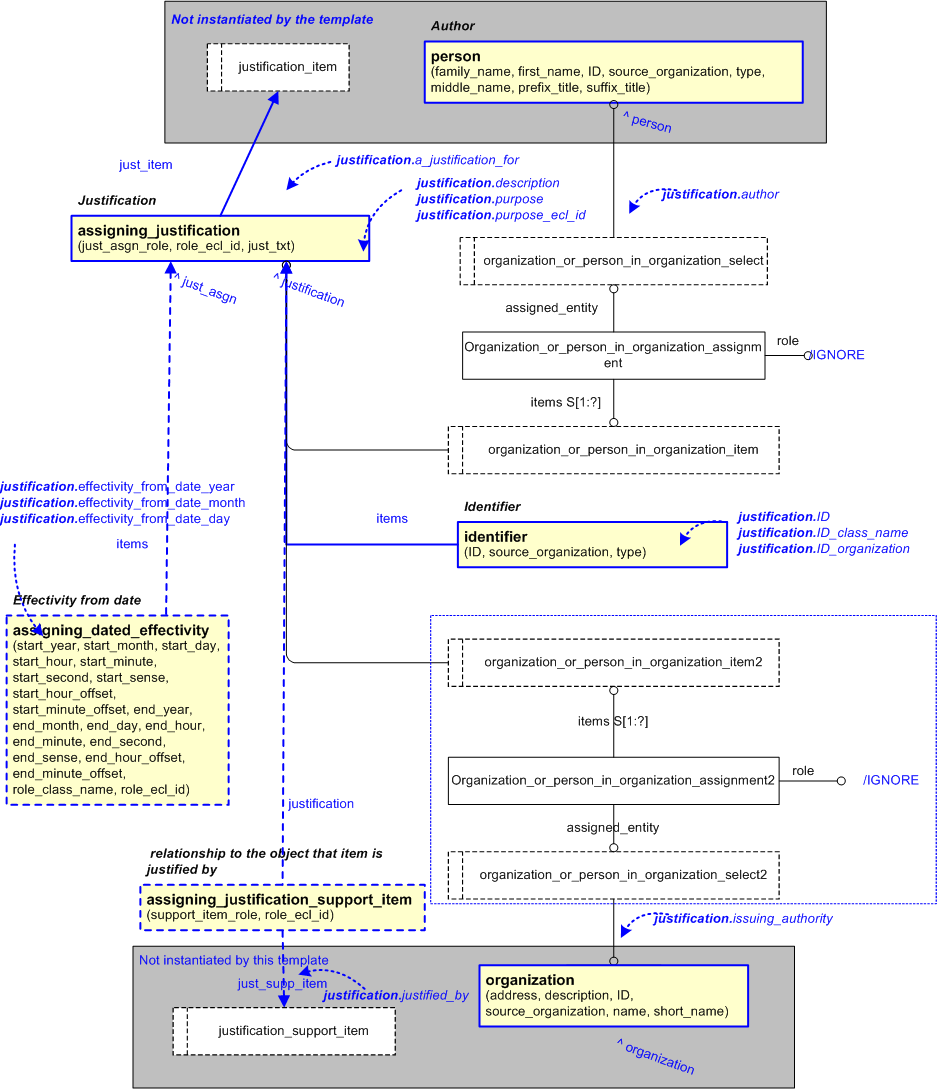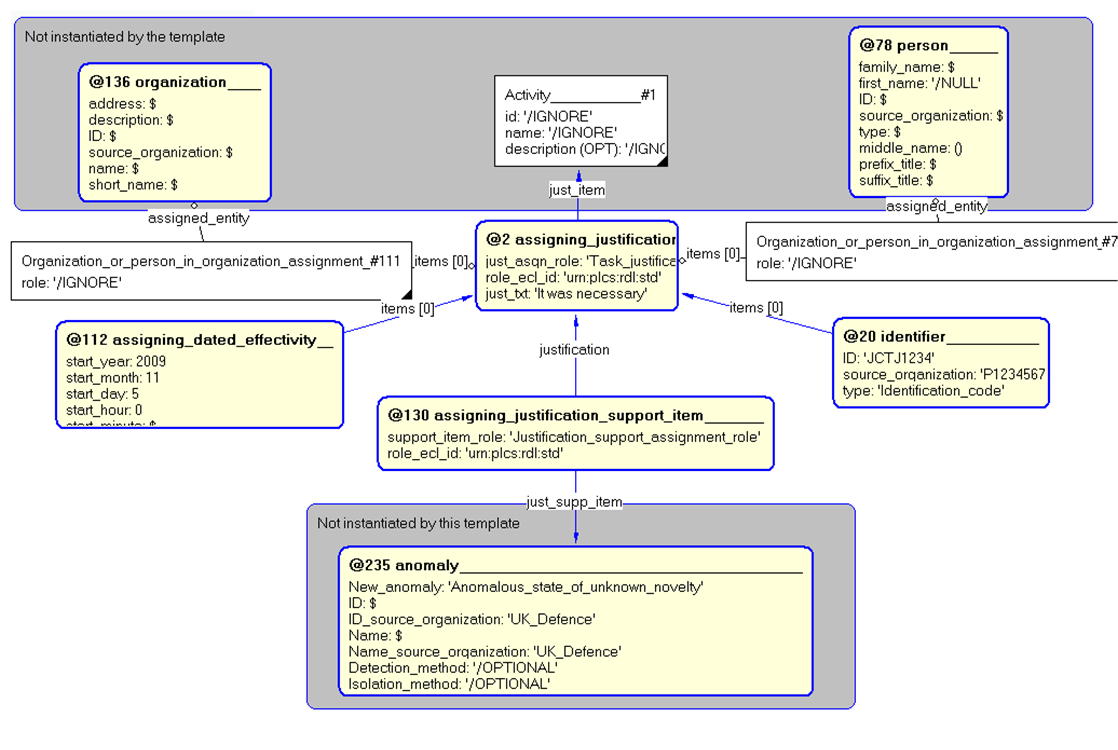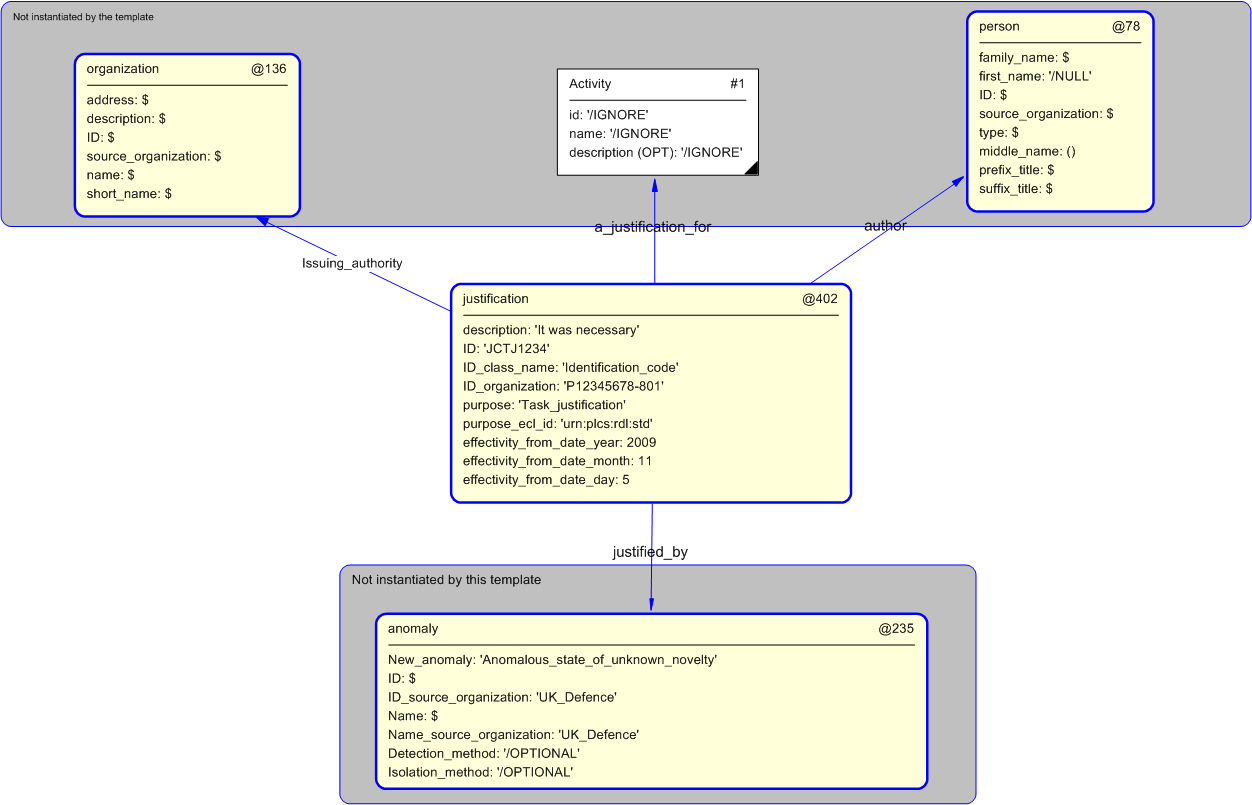Template:— justification (jstfn)
Context:— UK_Defence |
Date: 2009/11/06 15:29:01
Revision: 1.3
|
This section specifies the template justification.
NOTE
The template has been defined in the context of
UK_Defence.
Refer to the business context for details of related templates.
NOTE
An explanation of a template and the associated instantiation path is
provided in the
Template overview
section.
This template describes how to represent the UK_Defence concept of a Justification in terms of PLCS model elements (templates,
entities, and reference data).
This information object represents a justification for a decision or for something having been done.
Figure 1 — Graphical Representation for Business Object Justification
Justification:
The definition of a Justification is:
This information object represents a justification for a decision or for something having been done.
The item that is justified is defined by whatever references this object.
|
Attribute name
|
Attribute description
|
Attribute type
|
Optionality
|
| A justification for |
This is the reference to the item that is justified. |
SELECT |
Mandatory |
| Author |
This is the author of the justification. |
Person |
Mandatory |
| Description |
This is the description of the justification. |
intrinsic |
Mandatory |
| Effective from date |
This is the date on which the justification became effective. |
intrinsic |
Optional |
| ID |
This is the identifier of the justification. |
Identifier |
Mandatory |
| Issuing authority |
This is the reference to the person or organization that issued the justification.
This may or may not be the same as the person or organization that created the justification.
|
SELECT |
Optional |
| Justified by |
This is the reference to the information object that justifies the related information object referenced by attribute A Justification
For.
Example: a fault may justify a task being defined to prevent or correct it.
|
SELECT |
Optional |
| Purpose |
This is the purpose of the justification.
This might for example be a justification that is required for Project Management or QA purposes, or to satisfy
regulatory requirements.
|
intrinsic |
Mandatory |
Table 1 — Justification attribute details
The EXPRESS-G diagram in
Figure
2
shows the templates and EXPRESS entities that are required
to represent the template
"justification".
The text highlighted in blue shows the template parameters.
Figure 2 — An EXPRESS-G representation of the Information model for justification
The graphic for the template to be used in other EXPRESS-G diagrams
is shown in Figure
3
below.
Figure 3 — The graphical representation of the justification template
The following input parameters are defined for this template:
This is the description of the justification.
This is the identifier of the justification.
The type of identifier used for the parameter @justification_identifier.
The following classes and their sub-classes can be used:
The organization that owns the identifier specified by the parameter @justification_identifier.
This is the purpose of the justification.
EXAMPLE
This might for example be a justification that is required for Project Management or QA purposes, or to satisfy
regulatory requirements.
The following classes and their sub-classes can be used:
The identifier of the
External_class_library
storing the definition of the class referenced by the parameter @purpose.
This is the reference to the item that is justified.
This is the reference to the information object that justifies the related information object referenced by attribute
a_justification_for.
The person responsilbe for providing the justification.
This is the reference to the person or organization that issued the justification.
This may or may not be the same as the person or organization that created the justification.
Year_component of tthe date on which the justification became effective.
This parameter is optional. If not given, it will remain unset.
Month_component of tthe date on which the justification became effective.
This parameter is optional. If not given, it will remain unset.
Day_component of tthe date on which the justification became effective.
This parameter is optional. If not given, it will remain unset.
The following reference parameters are defined for this template:
Allow the
Justification
entity instantiated in this path to be referenced when this template is used.
Note: The
Justification
entity can be referenced in a template path by:
%^target = $justification.justification%
where
target
is the parameter to which the
Justification
is bound.
%^target = $justification.justification_assignment%
The following parameter combinations specify a uniqueness constraint:
Unique constraint: Justification
Each instance of the
entity
(
Justification)
within the data set shall be uniquely identified
by a combination of the following parameters on this
template (justification) namely:
ID,
a_justification_for.
The
instance is
referenced by the following template parameter:
justification.
The instantiation path shown below specifies the entities that are to be
instantiated by the template.
A description of templates and the syntax for the instantiation path is
provided in the
Templates Help/Information section.
-- Justification, Description, and Purpose /
assigning_justification(
just_item=@a_justification_for,
just_asgn_role=@purpose,
role_ecl_id=@purpose_ecl_id,
just_txt=@description)/
-- Assign reference parameters %^justification = $assigning_justification.justification%
%^justification_assignment = $assigning_justification.just_asgn%
-- Justification ID /
identifier(
items=^justification,
ID=@ID,
type=@ID_class_name,
source_organization=@ID_organization)/
-- [OPTIONAL effectivty date from] /
assigning_dated_effectivity(
start_year=@effectivity_from_date_year,
start_month=@effectivity_from_date_month,
start_day=@effectivity_from_date_day,
start_hour='0',
start_minute='0',
start_second='0',
start_sense='.EXACT.',
start_hour_offset='0',
start_minute_offset='0',
end_year='',
end_month='',
end_day='',
end_hour='0',
end_minute='0',
end_second='0',
end_sense='.EXACT.',
end_hour_offset='0',
end_minute_offset='0',
role_class_name='Actual_effectivity',
role_ecl_id='urn:plcs:rdl:uk_defence',
items=^justification_assignment)/
-- [OPTIONAL justified_by] /
assigning_justification_support_item(
support_item_role='Justification_support_assignment_role',
role_ecl_id='urn:plcs:rdl:std',
justification=^justification,
just_supp_item=@justified_by)/
-- Instantiate Organization_or_person_in_organization_assignment entity Organization_or_person_in_organization_assignment-- Set the Organization_or_person_in_organization_assignment attribute role to be ignored Organization_or_person_in_organization_assignment.role = '/IGNORE'
-- Assign the Organization_or_person_in_organization_assignment to the justification Organization_or_person_in_organization_assignment.items ->
^justification
-- Create the owned_by parameter Organization_or_person_in_organization_assignment.assigned_entity ->
@author-- [OPTIONAL issuing_authority] -- Instantiate Organization_or_person_in_organization_assignment entity Organization_or_person_in_organization_assignment-- Set the Organization_or_person_in_organization_assignment attribute role to be ignored Organization_or_person_in_organization_assignment.role = '/IGNORE'
-- Assign the Organization_or_person_in_organization_assignment to the justification Organization_or_person_in_organization_assignment.items ->
^justification
-- Create the owned_by parameter Organization_or_person_in_organization_assignment.assigned_entity ->
@issuing_authority
The following entities are instantiated with attributes as specified:
The instance diagram in Figure
4
shows an example of the EXPRESS entities and templates that are instantiated by the template:
/justification(description='It was necessary', ID='JCTJ1234', effectivity_from_date_year='2009', effectivity_from_date_month='11', effectivity_from_date_day='05', ID_class_name='Identification_code', ID_organization='P12345678-801', purpose='Task_justification', purpose_ecl_id='urn:plcs:rdl:std', a_justification_for='#1', justified_by='#235', author='#78', issuing_authority='#136')/
(an illustration of the consolidated justification template is shown in
Figure
5 below.)
Figure 4 — Entities instantiated by justification template
The instance diagram in
Figure
5
shows the graphic symbol for the template that is to be
used in other instance diagrams. The example template is:
/justification(description='It was necessary', ID='JCTJ1234', effectivity_from_date_year='2009', effectivity_from_date_month='11', effectivity_from_date_day='05', ID_class_name='Identification_code', ID_organization='P12345678-801', purpose='Task_justification', purpose_ecl_id='urn:plcs:rdl:std', a_justification_for='#1', justified_by='#235', author='#78', issuing_authority='#136')/
Figure 5 — Instantiation of justification template
Characterizations
No common characterizations of the template
justification
have been identified. However, the ISO 10303-239 EXPRESS model
may enable other assignments to the entities instantiated by the template.




